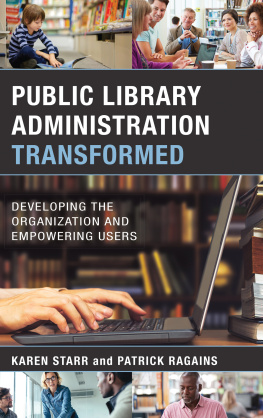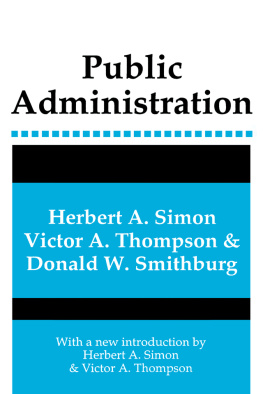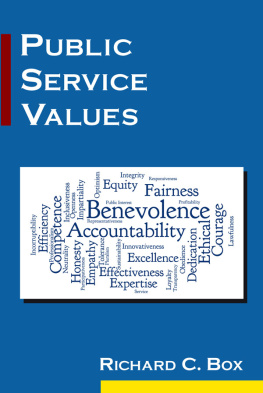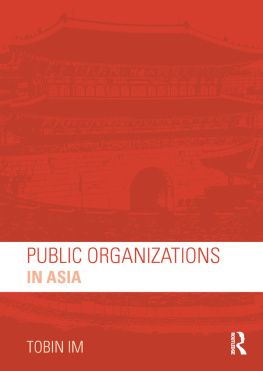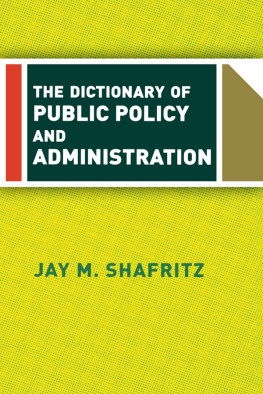THE PUBLIC
ADMINISTRATION
CASEBOOK
Robert A. Cropf
St. Louis University
Jennifer M. Giancola
St. Louis University
Kirsten Kim Loutzenhiser
Troy University
First published 2012 by Pearson Education, Inc.
Published 2016 by Routledge
2 Park Square, Milton Park, Abingdon, Oxon OX14 4RN
711 Third Avenue, New York, NY 10017, USA
Routledge is an imprint of the Taylor & Francis Group, an informa business
Copyright 2012 Taylor & Francis. All rights reserved.
All rights reserved. No part of this book may be reprinted or reproduced or utilised in any form or by any electronic, mechanical, or other means, now known or hereafter invented, including photocopying and recording, or in any information storage or retri eval system, without permission in writing from the publishers.
Notice:
Product or corporate names may be trademarks or registered trademarks, and are used only for identification and explanation without intent to infringe.
Credits and acknowledgments borrowed from other sources and reproduced, with permission, in this textbook appear on appropriate page within text.
ISBN: 9780205607419 (pbk)
Cover Designer: Suzanne Behnke
Library of Congress Cataloging-in-Publication Data
Cropf, Robert A.
The public administration casebook/Robert Cropf, Jennifer M. Giancola,
Kirsten Kim Loutzenhiser
p. cm.
Includes bibliographical references and index.
ISBN-13: 978-0-205-60741-9 (alk. paper)
ISBN-10: 0-205-60741-1 (alk. paper)
1. Public administrationUnited StatesCase studies. 2. Social action
United StatesCase Studies. 3. Social policyUnited StatesCase Studies
I. Giancola, Jennifer M. II. Title.
JK421.C77 2012
351.73dc22
2010053147
Introduction
(P) = Primary Focus
(S) = Secondary Focus
BUREAUCRACY AND STRUCTURE
LEADERSHIP
ETHICS
POLITICAL CONTEXT
DECISION MAKING
PLANNING
IMPLEMENTATION/EVALUATION
FINANCIAL MANAGEMENT
INTERGOVERNMENTAL AFFAIRS
HR ADMINISTRATION
SOCIAL EQUITY
COMMUNICATION
ORGANIZATIONAL CULTURE
STRATEGIC MANAGEMENT
DEMOCRACY
PRIVATIZATION
REFORM
OBJECTIVES AND OVERVIEW
Public policy, public administration, and, more generally, public service are showing renewed growth and vitality in terms of both educational and career opportunities. This is happening despite the continuing uncertainty regarding the economy and the restructuring of entire industrial sectors, including automobile manufacturing and finance. Indeed, issues associated with globalization, the environment, terrorism, immigration, and the economy all point to the importance of public policy and public administration in helping to find practicable solutions. Given the current political environment, it is critical that public service professionals are well prepared to tackle these and other key issues. Not only does this require the proper academic training, but it also demands extensive practice-based knowledge and skills. Much of the responsibility falls on public affairs/administration faculty and programs to better prepare practitioners.
Not only do students need better preparation for the public service, but the profile of these students is also rapidly changing with an increase of in-service, diverse, and nontraditional students including more females, part-time students, students attending two-year institutions, first-generation students, working adults, and students with one or more dependents (Choy, 2002; U.S. Department of Education, 2002). These trends are radically altering the face of higher education and, in particular, public administration programs (Loutzenhiser & Orman, 2005). Thus, there is an ongoing need for public administration programs to use teaching methods geared toward adult learners and other nontraditional studentsmethods referred to in the scholarly literature as andragogy (Knowles, 1988; Merriam & Caffarella, 1999). Andragogy attempts to facilitate more effective adult learning by integrating more of the learner's lived experience into the learning process. For these nontraditional students, pedagogical techniques that incorporate subject matter that relates directly to the their lives and is problem oriented as opposed to theoretical is the preferred method.
Why and for Whom Was the Book Written?
Dialogue with colleagues and professionals from the National Association of School of Public Affairs and Administration (NASPAA) led the authors to conclude that there is a need to meet the educational and professional requirements of a new generation of students in public administration undergraduate and graduate programs. A number of ideas were discussed for meeting these needs, including one that gave rise to this projecta book of real-life case studies written with working adults in mind. The case study method is one way to better meet the educational requirements of a wide range of students because the orientation of many of today's students tends to be more practice based and less theoretical in nature. Therefore, current learners appreciate efforts to bridge the gap between theory and practice. Although this is essential to any student of public administration (Reid & Miller, 1997), it is particularly salient for current students. However, there is a lack of texts that speak to the lived experience of students, ones that provide them with meaningful and relevant examples drawn from those experiences.
At the time of these discussions, a book such as this one did not exist. Thus, this book was written in order to provide students with applied examples incorporating workforce-relevant issues into the curriculum (White, 2004). This volume is the direct result of that discussion as well as subsequent conversations and other collaborations involving the authors. The case material contained herein is geared toward preparing students to become effective practitioners in the public and nonprofit sectors. The cases are written and compiled in such a way that they are all practice based and appeal to a variety of consumers, including traditional and nontraditional students. The book is designed to serve either as a companion to current introductory public administration textbooks or as a stand-alone casebook.
Unique Features of the Book
Another unique aspect of this casebook is that all the third authors of the cases were students. The cases are based on their actual experiences in organizational settings (see the later section on Casebook Methodology for additional information). A result of our students' deep involvement in the creation, development, and writing of each of these case studies is that the material better reflects current workplace realities and therefore results in a more meaningful learning experience for everyone. Specifically, the value of this approach is that it
Enhances pedagogy by providing a means for students to become deeply immersed in the learning process
Provides a teaching case methodology that serves as an easily adaptable model for other instructors
Stimulates more interest in the public administration issues and theories discussed in class: when students analyze the cases, they can see their direct relevance to actual workplace experience


